Notes: The construction of a railway north from Birmingham Snow Hill to Priestfield, where it would meet the Oxford, Worcester & Wolverhampton Railway (OW&WR) was authorised on 3 August 1846 to the Birmingham, Wolverhampton & Dudley Railway (BW&DR). The BW&DR favoured leasing the line to the Great Western Railway (GWR) from the offset as it planned the line to be constructed to the GWR’s broad gauge (7ft 0¼in) rather than what was, increasingly, the standard gauge (4ft 8½in). Negotiations with the GWR in regard to leasing and running the line started on 12 November 1846, only months after the railway company had been incorporated, and by Act of Parliament of 31 August 1848 the BW&DR was purchased by the GWR prior to any construction taking place. Construction of the line was started by the GWR during 1851 and by June 1852 the original Act was due to lapse and the GWR successfully applied to Parliament for a 3½-year extension to the original Act. The GWR had attempted not to construct the line at all preferring to negotiate with the London & North Western Railway (LNWR) to gain running rights along the Stour Valley line; negotiations failed as the, ever suspicious, LNWR was attempting to delay the GWR reaching its ultimate goal, Liverpool.

Construction was complete by the summer of 1854 and the line was duly inspected by Captain Sir Douglas Strutt-Galton in August. It is not recorded whether or not the inspection was a success, but, the following day a tubular bridge over the turnpike road at Winson Green collapsed following the passage of a contractor’s locomotive working a ballast train. Isambard Kingdom Brunel visited the line the following day and a thorough inspection of the bridges along the route with John Mc Clean, the resident engineer, resulted in five of them being condemned. The opening of the line had been set for 1 September 1854 but this was now unachievable as remedial work on the structures was to take some months. Following the strengthening of the five bridges the line was again inspected and passed fit for traffic, opening on 14 November 1854.
The station opened as simply Soho on 14 November 1854 and comprised of two platforms. The main station facilities were provided on the down (Wolverhampton direction) platform. Access to the station was from Talbot Street off the Soho Road with a driveway down to the station buildings. Two waiting rooms, a booking office and several ancillary buildings were provided on the platform along with a short canopy. Access to the up platform was via a footbridge or a flight of steps from the Soho Road (now Benson Road); two waiting rooms were provided on the platform with a signal box constructed between the footbridge and the waiting rooms. Directly opposite the signal box and beneath the footbridge was a crossover on the mixed gauge line. The station had the suffix Winson Green added to its name during 1893.
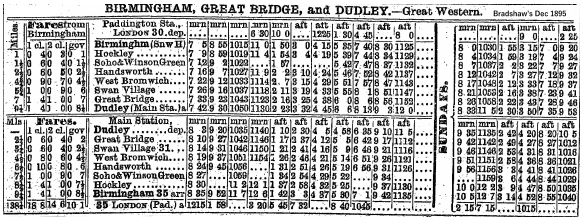
Capacity issues along the stretch of line from Hockley through to Handsworth Junction were addressed in the early twentieth century. The station was partially rebuilt with the down platform and original buildings left untouched but the up platform was demolished and rebuilt several feet further back; this, along with the extra space created with the removal of the broad gauge track, enabled an island platform to be constructed between the up and down platforms. A new footbridge to link all three platforms was constructed hard up against the, now, Benson Road overbridge. A new booking office was constructed at street level on Benson Road with a flight of steps down to the up platform and waiting rooms; toilets and offices were provided on the up and island platform. The northern set of lines through the station were denoted as the up and down main passenger with the southern pair being the up and down relief; a fifth running line was provided which ran to the rear of the original station buildings across what had been the 1854 station entrance. This fifth running line was actually the ‘Pilot Line’ and ran from Hockley Goods to Soho & Winson Green Goods, operated independently of the main running lines by the Commercial Shunters Department. The new quadruple-track section officially opened on 9 June 1912.
The GWR as a whole played a major part in the movement of troops and equipment prior to and during World War 1. In an effort to deter travel, owing to an excessive amount of extra train workings and a shortage of staff, the Snow Hill to Dudley service was withdrawn on 29 November .jpg) 1915 freeing up paths for the conveyance of troop, ammunition and ambulance trains. It was during a presentation ceremony to GWR staff for services during the Great War, on 1 January 1920, that Sir John Holder revealed that 762 ambulance trains had unloaded at either Snow Hill, for the General Hospital, or Soho, for the Dudley Road Hospital conveying 125,031 men for treatment. In total 2,390 ambulance trains had passed along the line transporting 380,000 wounded men. The presentation was to recognise the work that station staff contributed during the war, with the women receiving gold bracelets and the men, silver cigarette cases. 1915 freeing up paths for the conveyance of troop, ammunition and ambulance trains. It was during a presentation ceremony to GWR staff for services during the Great War, on 1 January 1920, that Sir John Holder revealed that 762 ambulance trains had unloaded at either Snow Hill, for the General Hospital, or Soho, for the Dudley Road Hospital conveying 125,031 men for treatment. In total 2,390 ambulance trains had passed along the line transporting 380,000 wounded men. The presentation was to recognise the work that station staff contributed during the war, with the women receiving gold bracelets and the men, silver cigarette cases.
At the time of the Big Four Grouping of 1 January 1923 Soho & Winson Green remained under the control of the GWR.
During the build-up to the Second World War three GWR stations in the Birmingham area were selected as the distribution points for Anderson shelters, named after Sir John Anderson (Home Secretary 1939-40), Soho & Winson Green being one of them; by March 1939 6,000 per week were being distributed. Again services were curtailed and speeds reduced for the duration of the conflict with many extra troop and ammunition trains being run.
On 1 January 1948 the railways were nationalised and Soho & Winson Green came under the control of British Railways (BR) Western Region (WR). During the London Midland Region’s (LMR) electrification programme of the West Coast Main Line (WCML), started in 1958, the line saw an increase in passenger services as many extra trains were run via the WR metals to compensate for the reduction in services on the WCML. Although this did not affect the service at Soho & Winson Green it seemed to cement the former GWR route as still being a primary main line. Plans revealed by BR(WR) in the early 1960s for the rebuilding of Snow Hill and the introduction of new diesel Pullman services all pointed towards the future being bright. On 1 January 1963 boundaries for BR regions were redrawn and Soho & Winson Green station came under the control of BR(LMR) and with the completion of the electrification programme and the linking of the main line from Paddington to Birmingham New Street the route north of Snow Hill was considered to be secondary. Towards the end of BR(WR) operation of Soho & Winson Green station totem nameplates were installed .
Soho & Winson Green station was renamed Winson Green on 14 June 1965, with at least one new running-in board giving the new name – in black capitals on a white board, not quite conforming to new ‘Corporate Identity’ policy. Rather than replace the totems with new signs, ‘Soho &’ was painted-over in WR chocolate-coloured paint: a cheap and unsightly solution which the LMR used at several other stations in the Birmingham area whose names had been abbreviated. Winson Green retained gas lighting.
The first service reduction occurred on 15 May 1964 with the withdrawal of the Snow Hill to Dudley working, followed in 1966 by BR(LMR) issuing a proposal to close the route, and all stations, in its entirety. In 1966 there were 24 trains in each direction to and from Wolverhampton, supplemented by 14 services to Stourbridge calling at Winson Green with around 2,000 people per day travelling on these services. Objections were posted to the Transport Users’ Consultative Committee (TUCC) and the case for closure was discussed on 20 September 1966. The recommendation of the TUCC was the line was to remain open as closure would cause ‘extreme hardship’. This ruling caused the LMR to change tactics with the announcement that as of 4 March 1967 the main line trains, along the whole route would be withdrawn and freight trains diverted along other routes. On 15 November 1967 the Minister of Transport, Barbara Castle responded to BR’s closure application refusing to allow the closure of the Wolverhampton to Snow Hill and the branch to Langley Green; but allowing the closure of the southern section from Snow Hill towards Stratford and Leamington. With the lack of through freight and express passenger services the four-track section between Handsworth and Hockley could no longer be justified, so in August 1968 it was announced that the main lines would be closed and all remaining traffic concentrated on the relief lines.
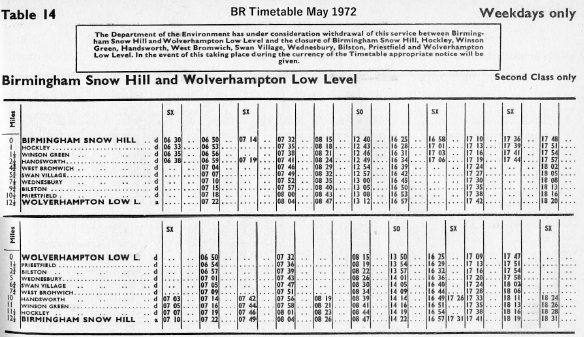
The introduction of the May 1969 timetable saw all stations between Wolverhampton Low Level and Birmingham Snow Hill inclusive become unstaffed halts. Monday 4 May 1969 was a significant day for the future of Soho & Winson Green with withdrawal of services south of Snow Hill and the tunnel and lines through to Moor Street taken out of use; coupled with this services from Stourbridge Junction were diverted into New Street although a shuttle was introduced between Snow Hill and Langley Green to connect with it. On the same day the service frequency was drastically reduced, this not requiring any permission from the TUCC or the Minister of Transport. The station now had just three morning and three evening services in each direction with a lunchtime Saturday only service to cater for shoppers on the Snow Hill to Wolverhampton service. The two-hourly Langley Green service was reduced to four down, Snow Hill to Langley Green, and five up services during peak times on Monday to Friday. By the end of 1970 the station had a very run-down feel with vandalism prevalent and passenger numbers had dwindled to less than a tenth of what they had been just four years previously. The newly-formed West Midlands Passenger Transport Authority (WMPTA) recognised the importance of the route although as it did not become responsible for local rail services until 1972 it could not react to the next move that BR made. Closure notices were posted.jpg) by BR on 31 March 1971 with the final date for objections to be received as 19 May 1971. The TUCC received 199 objections in total and on 25 May, they, along with representatives from BR and WMPTE (the Executive body of the WMPTA) inspected the route and all the stations, travelling from Snow Hill by train to Wolverhampton; ironically, they returned by bus! A Public Hearing was held at the Rainbow Suite in Birmingham on 14 July 1971 hear objections and decide the future of the line. The statement issued by the TUCC could not have been clearer ‘the addition of displaced rail passengers at these times would aggravate an already critical situation and would result in hardship for all concerned’. On 24 January 1972 the Minister granted permission for closure to be implemented with a date quickly set for 4 March. On the final day trains were expected to be heavily patronised, so, instead of being the usual single-car DMU the trains were strengthened to three-car units with BR issuing souvenir tickets. The final Wolverhampton-bound train called at Soho at around 17.55 with the final Birmingham bound service departing at around 18.05. A final service, hauled by a Class 47 locomotive, departed Snow Hill shortly after the final DMU but did not stop at the station. by BR on 31 March 1971 with the final date for objections to be received as 19 May 1971. The TUCC received 199 objections in total and on 25 May, they, along with representatives from BR and WMPTE (the Executive body of the WMPTA) inspected the route and all the stations, travelling from Snow Hill by train to Wolverhampton; ironically, they returned by bus! A Public Hearing was held at the Rainbow Suite in Birmingham on 14 July 1971 hear objections and decide the future of the line. The statement issued by the TUCC could not have been clearer ‘the addition of displaced rail passengers at these times would aggravate an already critical situation and would result in hardship for all concerned’. On 24 January 1972 the Minister granted permission for closure to be implemented with a date quickly set for 4 March. On the final day trains were expected to be heavily patronised, so, instead of being the usual single-car DMU the trains were strengthened to three-car units with BR issuing souvenir tickets. The final Wolverhampton-bound train called at Soho at around 17.55 with the final Birmingham bound service departing at around 18.05. A final service, hauled by a Class 47 locomotive, departed Snow Hill shortly after the final DMU but did not stop at the station.
Shortly after the final services ran and the lines fell silent the WMPTA moved to protect the trackbed from any future development, adopting this as official policy on 31 October 1973. The Authority and its Executive body worked tirelessly for the next decade to reintroduce rail services through the site of (Soho &) Winson Green station and on 5 October 1987 services once again began to run from Snow Hill to Kidderminster. The trackbed of the relief lines would be brought back into use from 31 May 1999 as Line 1 of the Midland Metro with a new Metro stop being constructed where the main passenger lines ran through the site of the station.
Today, very little remains of the station. On the Metro side everything associated with the former station has been swept away and nothing remains; on the heavy rail side (site of the relief lines) the mound of the former down (Wolverhampton-direction) platform can be made out amidst the undergrowth with a section of wall in situ by the 1900s booking office. The Metro services are frequent and reliable although they lack the appeal of a King or a Castle rattling through the station on a Birkenhead-bound express.
Tickets from Michael Stewart , route map by Alan Young and Totem from Richad Furness
Sources:
- Bradshaw's Railway Guide December 1895 - Middleton Press
- Bradshaw's Railway Guide July 1922 - Guild Publishing
- British Railways (WR) May - September timetble 1949
- British Rail (LMR) 3 May 1971 - 30 April 1972 timetable
- Forgotten Railways: Volume 10, The West Midlands - Rex Christinsen - David & Charles Publishing 1985
- A Regional History of the Railways of Great Britain - Volume 7 The West Midlands - Rex Christiansen - David St John Thomas Publisher 1991
- A Century of Railways around Birmingham and the West Midlands Vol 1,2 & 3 - John Boynton - Mid England Books Publisher 1999
- From Main Line To Metro - John Boynton - Mid England Books 2001
To see the
other stations on the Birmingham Snow Hill - Chester General line
click on the station name: Birmingham Snow Hill, Hockley,
Handsworth, The Hawthorns, West Bromwich, Swan Village,
Wednesbury, Bradley & Moxley, Bilston , Priestfield, Wolverhampton Low Level, Dunstall Park, Stafford Road, New Hadley Halt, Admaston Halt,
Walcot, Upton Magna, Abbey Foregate, Shrewsbury S&C,
Leaton, Oldwoods Halt, Baschurch, Stanwardine Halt, Haughton Halt,
Rednal & West Felton, Whittington Low Level, Weston Rhyn, Whitehurst Halt, Rhosymedre, Rhosymedre Halt, Wynville Halt, Rhos, Johnstown & Hafod, Rhosrobin Halt, Gresford, Rossett, Pulford, Balderton and Saltney |

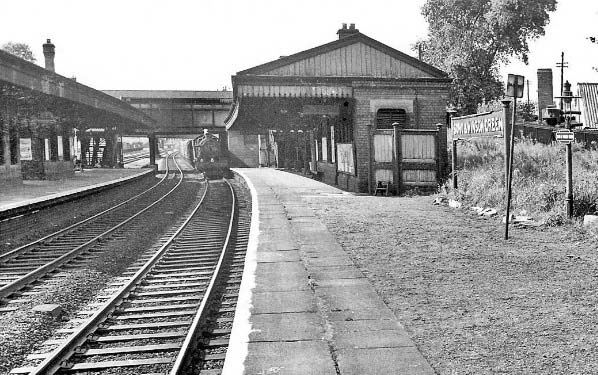
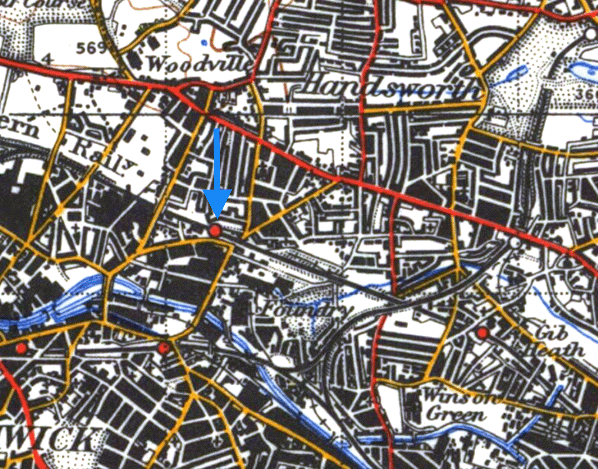
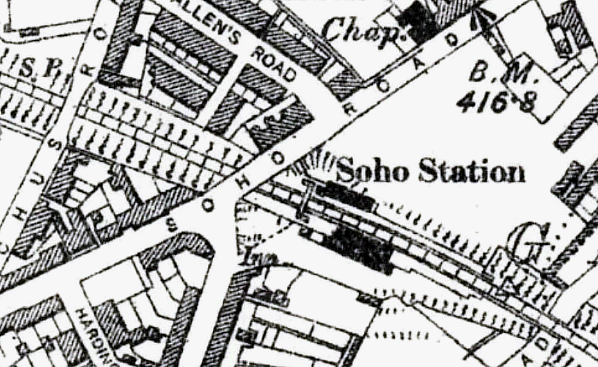
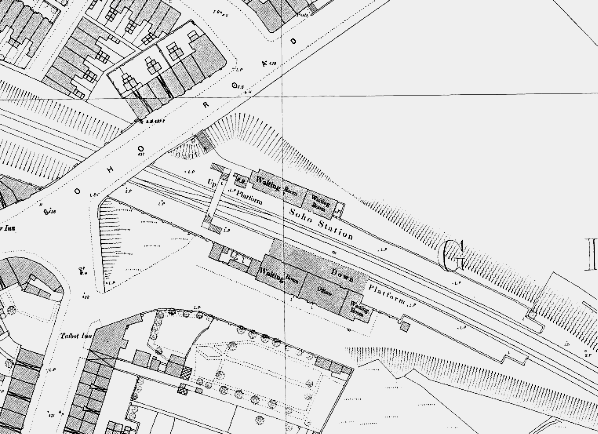
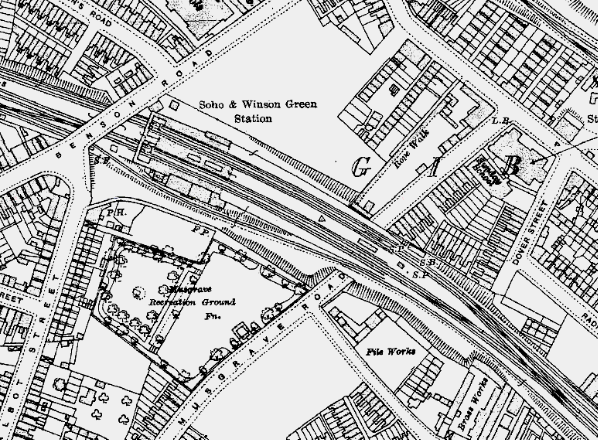 The 1918 1:2500 map shows the sation following the quadrupling of the lines through the station. The Pilot line can be seen running through, what was, the station forecourt.
The 1918 1:2500 map shows the sation following the quadrupling of the lines through the station. The Pilot line can be seen running through, what was, the station forecourt.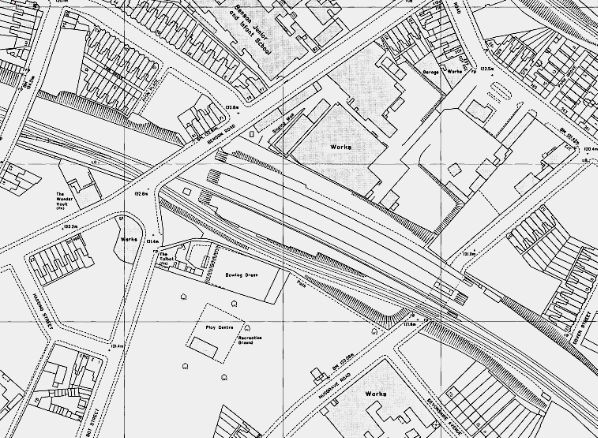
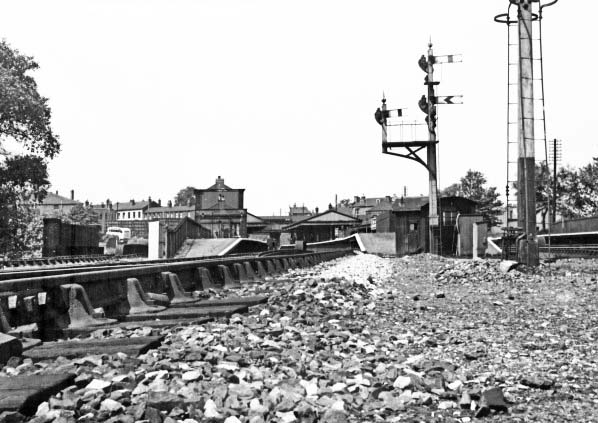 Looking towards Wolverhampton along the relief lines in 1961 with some wonderful wooden signal posts in the foreground. The original station building, located on the down platform, can be seen along with the Pilot lines running to the rear of it.
Looking towards Wolverhampton along the relief lines in 1961 with some wonderful wooden signal posts in the foreground. The original station building, located on the down platform, can be seen along with the Pilot lines running to the rear of it.


.jpg) 1915 freeing up paths for the conveyance of troop, ammunition and ambulance trains. It was during a presentation ceremony to GWR staff for services during the Great War, on 1 January 1920, that Sir John Holder revealed that 762 ambulance trains had unloaded at either Snow Hill, for the General Hospital, or Soho, for the Dudley Road Hospital conveying 125,031 men for treatment. In total 2,390 ambulance trains had passed along the line transporting 380,000 wounded men. The presentation was to recognise the work that station staff contributed during the war, with the women receiving gold bracelets and the men, silver cigarette cases.
1915 freeing up paths for the conveyance of troop, ammunition and ambulance trains. It was during a presentation ceremony to GWR staff for services during the Great War, on 1 January 1920, that Sir John Holder revealed that 762 ambulance trains had unloaded at either Snow Hill, for the General Hospital, or Soho, for the Dudley Road Hospital conveying 125,031 men for treatment. In total 2,390 ambulance trains had passed along the line transporting 380,000 wounded men. The presentation was to recognise the work that station staff contributed during the war, with the women receiving gold bracelets and the men, silver cigarette cases.
.jpg) by BR on 31 March 1971 with the final date for objections to be received as 19 May 1971. The TUCC received 199 objections in total and on 25 May, they, along with representatives from BR and WMPTE (the Executive body of the WMPTA) inspected the route and all the stations, travelling from Snow Hill by train to Wolverhampton; ironically, they returned by bus! A Public Hearing was held at the Rainbow Suite in Birmingham on 14 July 1971 hear objections and decide the future of the line. The statement issued by the TUCC could not have been clearer ‘the addition of displaced rail passengers at these times would aggravate an already critical situation and would result in hardship for all concerned’. On 24 January 1972 the Minister granted permission for closure to be implemented with a date quickly set for 4 March. On the final day trains were expected to be heavily patronised, so, instead of being the usual single-car DMU the trains were strengthened to three-car units with BR issuing souvenir tickets. The final Wolverhampton-bound train called at Soho at around 17.55 with the final Birmingham bound service departing at around 18.05. A final service, hauled by a Class 47 locomotive, departed Snow Hill shortly after the final DMU but did not stop at the station.
by BR on 31 March 1971 with the final date for objections to be received as 19 May 1971. The TUCC received 199 objections in total and on 25 May, they, along with representatives from BR and WMPTE (the Executive body of the WMPTA) inspected the route and all the stations, travelling from Snow Hill by train to Wolverhampton; ironically, they returned by bus! A Public Hearing was held at the Rainbow Suite in Birmingham on 14 July 1971 hear objections and decide the future of the line. The statement issued by the TUCC could not have been clearer ‘the addition of displaced rail passengers at these times would aggravate an already critical situation and would result in hardship for all concerned’. On 24 January 1972 the Minister granted permission for closure to be implemented with a date quickly set for 4 March. On the final day trains were expected to be heavily patronised, so, instead of being the usual single-car DMU the trains were strengthened to three-car units with BR issuing souvenir tickets. The final Wolverhampton-bound train called at Soho at around 17.55 with the final Birmingham bound service departing at around 18.05. A final service, hauled by a Class 47 locomotive, departed Snow Hill shortly after the final DMU but did not stop at the station.
 The booking office built to allow construction of the Pilot line in 1912 seen here after 1969 when the stations became unstaffed halts; a BR PayTrain guide poster can be seen to the left of the door.
The booking office built to allow construction of the Pilot line in 1912 seen here after 1969 when the stations became unstaffed halts; a BR PayTrain guide poster can be seen to the left of the door.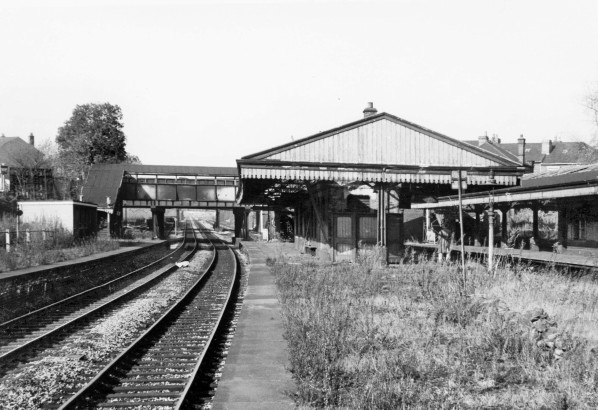



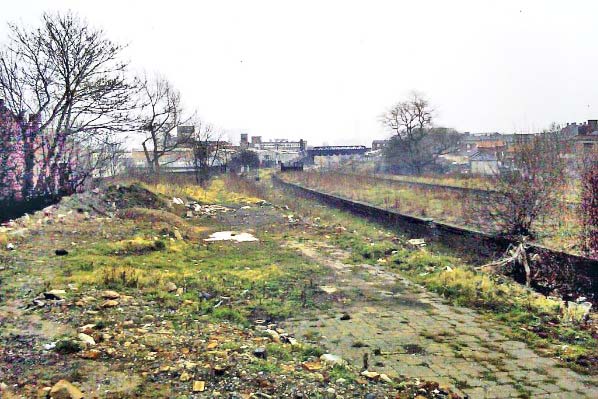 The station site was a sad and sorry sight in 1986 when this picture was taken from the Benson Road overbridge looking towards Birmingham. The tiles of the up main platform can be clearly made out in the foreground with the large island platform to the right.
The station site was a sad and sorry sight in 1986 when this picture was taken from the Benson Road overbridge looking towards Birmingham. The tiles of the up main platform can be clearly made out in the foreground with the large island platform to the right.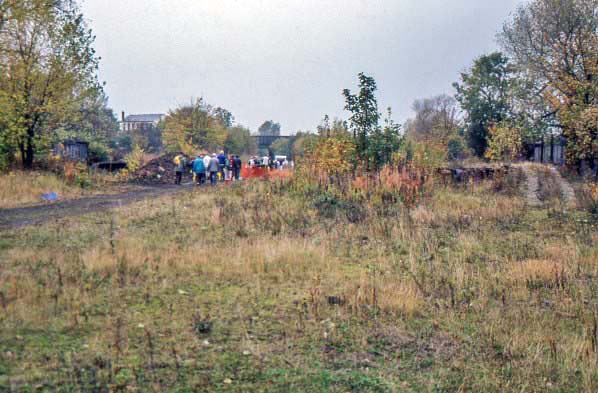 The station site viewed from the south end looking towards Wolverhampton on 1 October 1990 during a Centro chrity walk from Snow Hill to Handsworth. The mound of the up main platform is still quite visible with the island platform obscured by the tree to the centre. The down relief platform looks to have been recently demolished with fresh rubble to the left of the walkers.
The station site viewed from the south end looking towards Wolverhampton on 1 October 1990 during a Centro chrity walk from Snow Hill to Handsworth. The mound of the up main platform is still quite visible with the island platform obscured by the tree to the centre. The down relief platform looks to have been recently demolished with fresh rubble to the left of the walkers.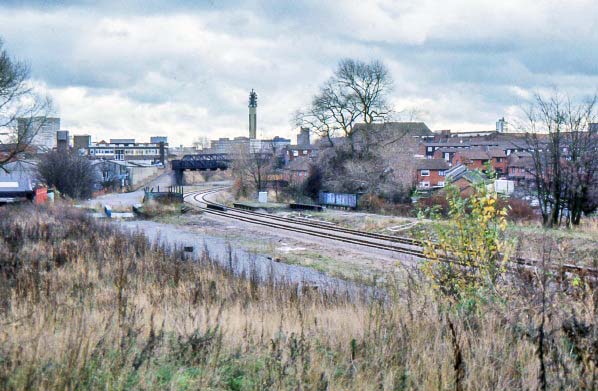 By the time this view, looking towards Birmingham, was taken on 4 December 1994 heavy rail has been laid on the trackbed of the former relief lines. The former main line alignment, in the foreground, and platforms have been cleared to allow the track for the Midlands Metro to be laid.
By the time this view, looking towards Birmingham, was taken on 4 December 1994 heavy rail has been laid on the trackbed of the former relief lines. The former main line alignment, in the foreground, and platforms have been cleared to allow the track for the Midlands Metro to be laid.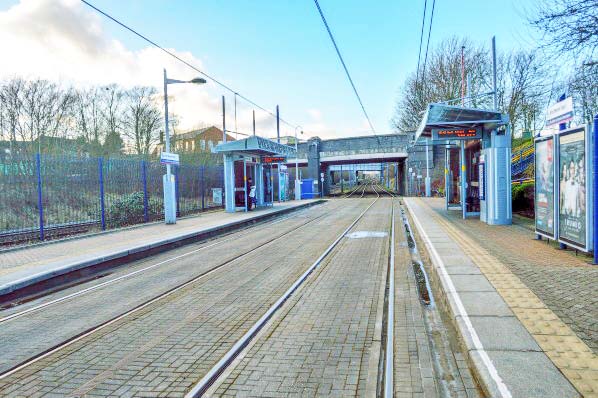 Looking north, towards Wolverhampton, on 31 January 2016 from the site of the up main platform. The Soho & Benson Road tram stop stands on the site of the main lines with the former relief lines running behind the blue fencing to the left.
Looking north, towards Wolverhampton, on 31 January 2016 from the site of the up main platform. The Soho & Benson Road tram stop stands on the site of the main lines with the former relief lines running behind the blue fencing to the left.
 Home Page
Home Page